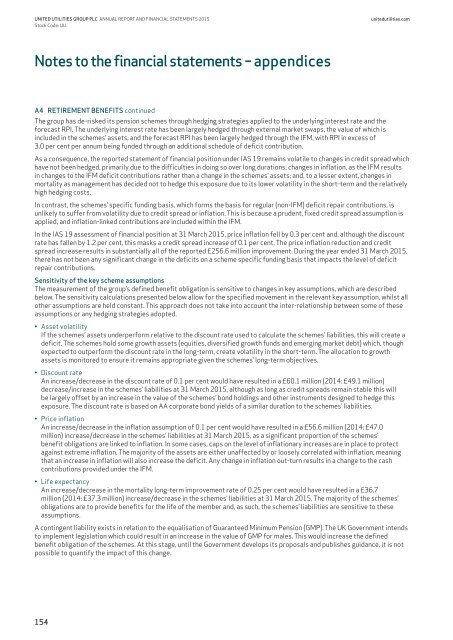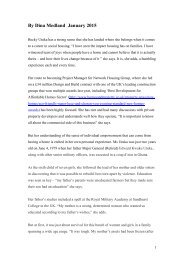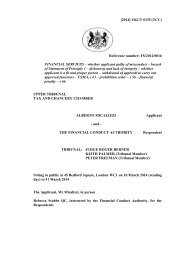united-utilities-annual-report-2015
united-utilities-annual-report-2015
united-utilities-annual-report-2015
Create successful ePaper yourself
Turn your PDF publications into a flip-book with our unique Google optimized e-Paper software.
UNITED UTILITIES GROUP PLC ANNUAL REPORT AND FINANCIAL STATEMENTS <strong>2015</strong>Stock Code: UU.<strong>united</strong><strong>utilities</strong>.comNotes to the financial statements – appendicesA4 RETIREMENT BENEFITS continuedThe group has de-risked its pension schemes through hedging strategies applied to the underlying interest rate and theforecast RPI. The underlying interest rate has been largely hedged through external market swaps, the value of which isincluded in the schemes’ assets, and the forecast RPI has been largely hedged through the IFM, with RPI in excess of3.0 per cent per annum being funded through an additional schedule of deficit contribution.As a consequence, the <strong>report</strong>ed statement of financial position under IAS 19 remains volatile to changes in credit spread whichhave not been hedged, primarily due to the difficulties in doing so over long durations; changes in inflation, as the IFM resultsin changes to the IFM deficit contributions rather than a change in the schemes’ assets; and, to a lesser extent, changes inmortality as management has decided not to hedge this exposure due to its lower volatility in the short-term and the relativelyhigh hedging costs.In contrast, the schemes’ specific funding basis, which forms the basis for regular (non-IFM) deficit repair contributions, isunlikely to suffer from volatility due to credit spread or inflation. This is because a prudent, fixed credit spread assumption isapplied, and inflation-linked contributions are included within the IFM.In the IAS 19 assessment of financial position at 31 March <strong>2015</strong>, price inflation fell by 0.3 per cent and, although the discountrate has fallen by 1.2 per cent, this masks a credit spread increase of 0.1 per cent. The price inflation reduction and creditspread increase results in substantially all of the <strong>report</strong>ed £256.6 million improvement. During the year ended 31 March <strong>2015</strong>,there has not been any significant change in the deficits on a scheme specific funding basis that impacts the level of deficitrepair contributions.Sensitivity of the key scheme assumptionsThe measurement of the group’s defined benefit obligation is sensitive to changes in key assumptions, which are describedbelow. The sensitivity calculations presented below allow for the specified movement in the relevant key assumption, whilst allother assumptions are held constant. This approach does not take into account the inter-relationship between some of theseassumptions or any hedging strategies adopted.• Asset volatilityIf the schemes’ assets underperform relative to the discount rate used to calculate the schemes’ liabilities, this will create adeficit. The schemes hold some growth assets (equities, diversified growth funds and emerging market debt) which, thoughexpected to outperform the discount rate in the long-term, create volatility in the short-term. The allocation to growthassets is monitored to ensure it remains appropriate given the schemes’ long-term objectives.• Discount rateAn increase/decrease in the discount rate of 0.1 per cent would have resulted in a £60.1 million (2014: £49.1 million)decrease/increase in the schemes’ liabilities at 31 March <strong>2015</strong>, although as long as credit spreads remain stable this willbe largely offset by an increase in the value of the schemes’ bond holdings and other instruments designed to hedge thisexposure. The discount rate is based on AA corporate bond yields of a similar duration to the schemes’ liabilities.• Price inflationAn increase/decrease in the inflation assumption of 0.1 per cent would have resulted in a £56.6 million (2014: £47.0million) increase/decrease in the schemes’ liabilities at 31 March <strong>2015</strong>, as a significant proportion of the schemes’benefit obligations are linked to inflation. In some cases, caps on the level of inflationary increases are in place to protectagainst extreme inflation. The majority of the assets are either unaffected by or loosely correlated with inflation, meaningthat an increase in inflation will also increase the deficit. Any change in inflation out-turn results in a change to the cashcontributions provided under the IFM.• Life expectancyAn increase/decrease in the mortality long-term improvement rate of 0.25 per cent would have resulted in a £36.7million (2014: £37.3 million) increase/decrease in the schemes’ liabilities at 31 March <strong>2015</strong>. The majority of the schemes’obligations are to provide benefits for the life of the member and, as such, the schemes’ liabilities are sensitive to theseassumptions.A contingent liability exists in relation to the equalisation of Guaranteed Minimum Pension (GMP). The UK Government intendsto implement legislation which could result in an increase in the value of GMP for males. This would increase the definedbenefit obligation of the schemes. At this stage, until the Government develops its proposals and publishes guidance, it is notpossible to quantify the impact of this change.154




